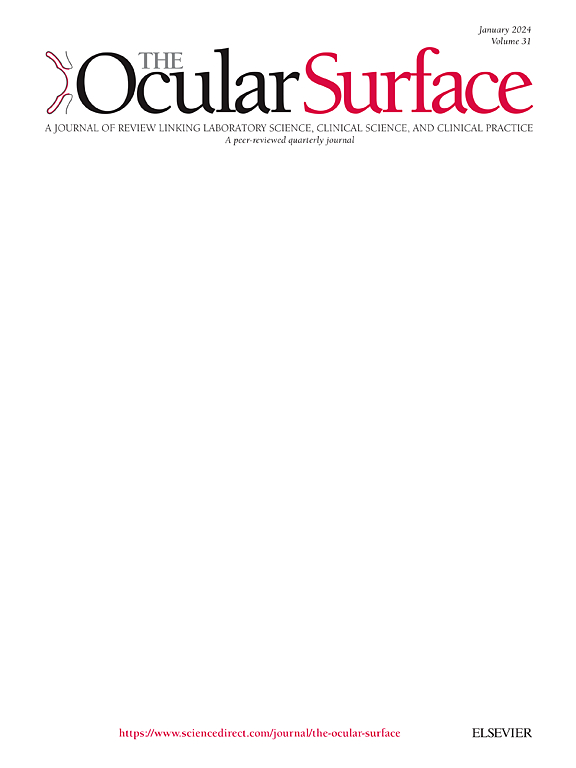New insight into the neuroimmune interplay in Pseudomonas aeruginosa keratitis
IF 5.6
1区 医学
Q1 OPHTHALMOLOGY
引用次数: 0
Abstract
Purpose
This research aims to reveal the roles of the miR-183/96/182 cluster (miR-183C) in sensory neurons (SN) in the interplay of corneal sensory nerves (CSN) and myeloid cells (MC) during Pseudomonas aeruginosa (PA) keratitis.
Methods
The left corneas of SN-specific (SNS) conditional knockout (CKO) and their wild type (WT) littermates were infected with PA. CSN of these mice express RFP; MC EGFP. Confocal microscopy of corneal flatmount, myeloperoxidase (MPO) assay and plate count were performed.
Results
In WT mice, CSN began to degenerate at 3 h-post-infection (hpi), starting from epithelial/subepithelial layers in the central region. By 1 day-post-infection (dpi), epithelium/subepithelial CSN were nearly completely destroyed, while stromal nerves persisted. From 3 dpi, CSN were obliterated in both layers. In CKO vs WT mice, CSN density was decreased at 3 and 6 hpi; however, CNS degeneration followed a slower pace. At 3 dpi, residual large-diameter stromal CSN were better preserved.
MC were decreased in the central cornea at 3 and 6 hpi, but increased in the periphery, more prominent in CKO mice. At 12 hpi, densely packed MC formed a ring-shaped band circling a “dark” zone nearly devoid of MC, colocalizing with CSN most degenerated central area. At 1 dpi, the cornea was filled with MC; MC density was lower in CKO. CKO mice had decreased neutrophils at 1 dpi and reduced disease severity at 3 dpi.
Conclusions
Our results provide new insight into the neuroimmune interplay during PA keratitis. miR-183C in CSN modulates PA keratitis through regulation of neuroimmune interaction.
铜绿假单胞菌性角膜炎的神经免疫相互作用新认识
目的:本研究旨在揭示在铜绿假单胞菌(PA)性角膜炎中,感觉神经元中miR-183/96/182簇(miR-183C)在角膜感觉神经(CSN)和髓样细胞(MC)相互作用中的作用。方法:对sn特异性(SNS)条件敲除(CKO)的左眼角膜及其野生型(WT)幼崽进行PA感染。这些小鼠的CSN表达RFP;MC EGFP。角膜平片共聚焦显微镜,髓过氧化物酶(MPO)测定和平板计数。结果:在WT小鼠中,CSN在感染后3小时(hpi)开始变性,从中央区域的上皮/上皮下层开始。感染后1天(dpi),上皮/上皮下CSN几乎完全破坏,而间质神经持续存在。从3 dpi开始,两层的CSN均被抹去。在CKO和WT小鼠中,CSN密度在3和6 hpi时降低;然而,中枢神经系统退化的速度较慢。3 dpi时,残余大直径间质CSN保存较好。在3和6 hpi时,中央角膜MC减少,而周围角膜MC增加,在CKO小鼠中更为明显。在12 hpi时,密集的MC形成一个环状带,环绕着一个几乎没有MC的“黑暗”区,与CSN最退化的中心区共域。在1 dpi时,角膜充满MC;CKO组MC密度较低。CKO小鼠在1 dpi时中性粒细胞减少,在3 dpi时疾病严重程度降低。结论:我们的研究结果为PA角膜炎的神经免疫相互作用提供了新的见解。CSN中的miR-183C通过调节神经免疫相互作用调节PA角膜炎。
本文章由计算机程序翻译,如有差异,请以英文原文为准。
求助全文
约1分钟内获得全文
求助全文
来源期刊

Ocular Surface
医学-眼科学
CiteScore
11.60
自引率
14.10%
发文量
97
审稿时长
39 days
期刊介绍:
The Ocular Surface, a quarterly, a peer-reviewed journal, is an authoritative resource that integrates and interprets major findings in diverse fields related to the ocular surface, including ophthalmology, optometry, genetics, molecular biology, pharmacology, immunology, infectious disease, and epidemiology. Its critical review articles cover the most current knowledge on medical and surgical management of ocular surface pathology, new understandings of ocular surface physiology, the meaning of recent discoveries on how the ocular surface responds to injury and disease, and updates on drug and device development. The journal also publishes select original research reports and articles describing cutting-edge techniques and technology in the field.
Benefits to authors
We also provide many author benefits, such as free PDFs, a liberal copyright policy, special discounts on Elsevier publications and much more. Please click here for more information on our author services.
Please see our Guide for Authors for information on article submission. If you require any further information or help, please visit our Support Center
 求助内容:
求助内容: 应助结果提醒方式:
应助结果提醒方式:


